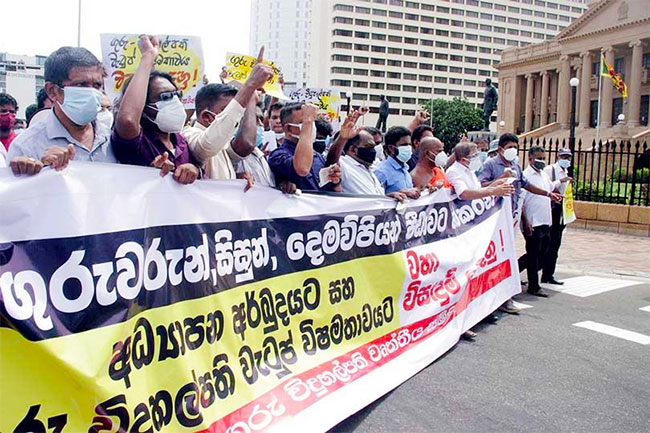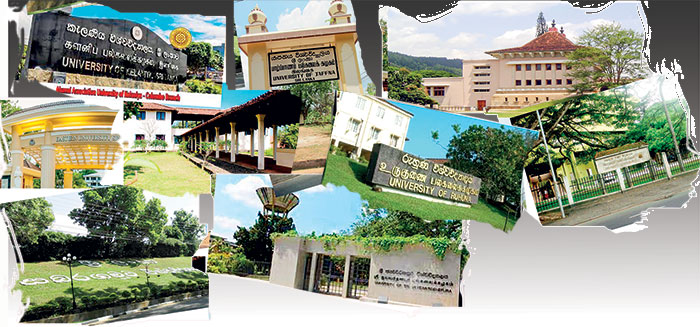By Ramya Kumar
Earlier this month the Cabinet approved a proposal presented by the President (as Minister of Defence) to admit fee-levying local students to the medical faculty of the Kotelawala Defence University (KDU). Thereafter, the KDU posted a call for applications from local students (‘day scholars’) to its MBBS programme with a May 5th, 2024, deadline—barely two weeks after the call appeared on the KDU website.
Medical education is delivered by 13 state medical faculties, 12 under the purview of the University Grants Commission (UGC), plus KDU. Students who obtain the required Z scores at the local A/Ls are eligible for admission to the UGC medical schools on a non-fee levying basis, with a limited number of seats (up to 5%) open to international students who pay USD 62,500 (USD 12,500×5) for their MBBS. KDU’s medical faculty, functioning under the Ministry of Defence, admits military cadres, along with a growing number of fee-paying international students and non-resident Sri Lankans. In other words, none of the existing state medical faculties, including KDU, have enrolled fee-paying local students to this day.
Expansion of private/fee-levying medical education has been resisted by student movements and others concerned about quality of/equity in medical education. In 2021, the government tried to stealthily introduce fee-levying medical education through the Kotelawala National Defence University Bill, which, if enacted, would have permitted the enrolment of local medical students to KDU on a fee-levying basis. Now, with apparently no regard for the law or due process, the Cabinet has approved the President’s proposal, which, if implemented, will drastically alter the landscape of medical education in the country.
Admission criteria
The KDU website lists the admission criteria for its MBBS programme for local day scholars. They should be “unmarried” Sri Lankan citizens in the age group 17-24 years who have completed the G.C.E. (A/L) examination in the year 2022 (or local/foreign equivalent in 2023) and followed the Bio-Science stream (Biology, Chemistry and Physics) and obtained a minimum of two Credit Passes (C) and one Simple Pass (S) (or equivalent at the Cambridge/Edexcel examination) in one sitting, as specified in the Minimum Standards of Medical Education.
These admission criteria expand the pool of eligible candidates by a sizeable proportion since all students with two Cs and an S in bio-sciences may apply. However, the KDU provides very little information about the process they will follow to select candidates (how many?) from this very large pool, except to say that it will involve shortlisting applicants based on their Z score /grades and a “structured selection interview” where the Board of Management will hold “exclusive rights” in selection.
Who will have access
The five-year course will levy LKR 2.5 million per year for five years, amounting to LKR 12.5 million, the equivalent of about USD 42,000. The call for applications does not refer to scholarships or grants for those who may not be able to afford the fees—aspects emphasized in the government’s proposals to expand private higher education detailed in the controversial National Education Policy Framework (NEPF). Apart from the privileged students whose parents can easily afford the fees, others will also be able to sell their assets and take on debt to pay for a MBBS degree. Yet, the application process will be biased in favour of students from elite backgrounds who are better trained to navigate interviews and speak in English.
Indeed, medicine has become an elite profession in many countries due to interview processes that rank applicants based on “soft-skills” and involvement in extra-curricular activities, community service, and other achievements—opportunities that are usually available to a certain class of people. Meanwhile, in Sri Lanka, a phone call to the KDU’s Board of Management from ‘someone who knows someone’ may increase the chances of some candidates securing seats over others. It is widely known that the North Colombo Medical College (NCMC) and SAITM became lodestones for the offspring of doctors.
Questionable justification
With several private medical schools undergoing the Sri Lanka Medical Council’s (SLMC) vetting process, privatizing medical education is justified by politicians, medical professionals and other interlocutors, as a solution to the mass exodus of doctors to greener pastures. Whether the expansion of opportunities for fee-levying/private medical education will actually address the medical brain drain is questionable. For one, it is unrealistic to anticipate that fee-paying medical graduates will remain in the country when lucrative career opportunities are abundant in the West. Even if they do remain here, with hefty fees and the debt incurred to pay them, it is unlikely that they would opt to serve in the public system in remote areas like Padaviya or Puthukkudiyiruppu, where private practice will be limited.
Two strategies are currently used to retain medical professionals in rural areas: the district quotas and mandatory post-internship appointments. First, the district quota system, an affirmative action policy implemented by the UGC, tries to compensate for the deep-seated urban-rural disparities that choke the general education system, and also supports rural retention because medical graduates recruited from these areas are more likely to serve in their home districts/provinces. Second, the Ministry of Health requires all the newly registered doctors it employs to complete a post-internship appointment at an allotted institution, ensuring a widely dispersed medical workforce. Such mandatory service requirements can be implemented at this time because the public system is still the primary employer of medical professionals in the country. Privatising medical education alongside state-incentivised expansion of the commercial hospital sector can facilitate brain drain from public to private, creating a dearth of physicians for the public sector, especially in rural areas, as has happened in India, Thailand, and Malaysia.
There is also the argument that permitting local students access to fee-levying medical education will save the country foreign exchange. Although expanding opportunities at state medical faculties may do this to a certain extent, the government aspires to attract foreign investors into the higher education sector. As stated in the NEPF, “Limits to ownership by foreign investors in Higher Education and Skills Development shall be removed with an investment threshold to attract high quality institutions.” In reality, international universities are driven by profit to be incurred locally and channelled overseas.
‘Strategic planning’
The government has craftily planned its strategy to expand private medical education post-Aragalaya. While state funding for state universities has been slashed to new lows, university administrations have been directed to self-generate funds through fee-levying degree programmes. The slightest form of protest by the student movement has been quickly stifled with many medical students and others arrested or facing intimidation from the military and law enforcement authorities. The state’s propaganda machine has painted a picture of perpetually protesting students and self-interested university teachers. Middle-class sentiments regarding state universities are at an all-time low with the Colombo elite vocally denigrating state universities and their graduates, while promoting private higher education.
Although there is wide consensus that the advent of private medical schools should not affect the delivery of state MBBS programmes, there are no mechanisms in place to ensure this. The SLMC’s accreditation standards consider state medical schools and others on par with each other, and the government has failed to take effective measures to strengthen medical faculties located in peripheral districts. Even today, certain medical faculties struggle to gain SLMC accreditation owing to a dearth of staff in their professorial units. There is no doubt that the more lucrative fee-levying medical schools will prey on the scarce resources of state medical faculties, making this situation worse.
Why is our generation who has benefitted from the Free Education policy so ready to give it up for future generations? Privatisation is not a solution to the many problems of and faced by the university system. Reforms are needed, but we need to arrive at these through a process of consultation. Rather than pushing through hasty, short-sighted educational reforms that appear to be driven by economic imperatives and narrow class interests, why not work on strengthening what we presently have?
It is no coincidence that KDU—an institution that can easily deploy the military—has been selected as the first experiment. Any resistance will be easily quelled unless there is a groundswell of public protest against these developments and other attempts to subvert Free Education in this country. While these decisions are being made by a President and Cabinet who have long lost whatever mandate they had, it is crucial that those aspiring to take over unambiguously express their views on this as a matter of urgency.


